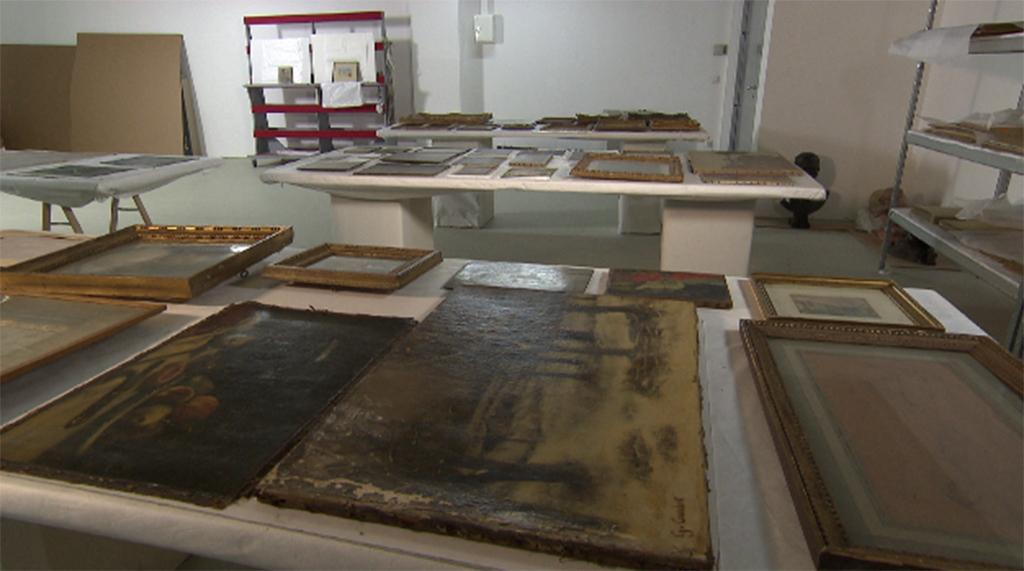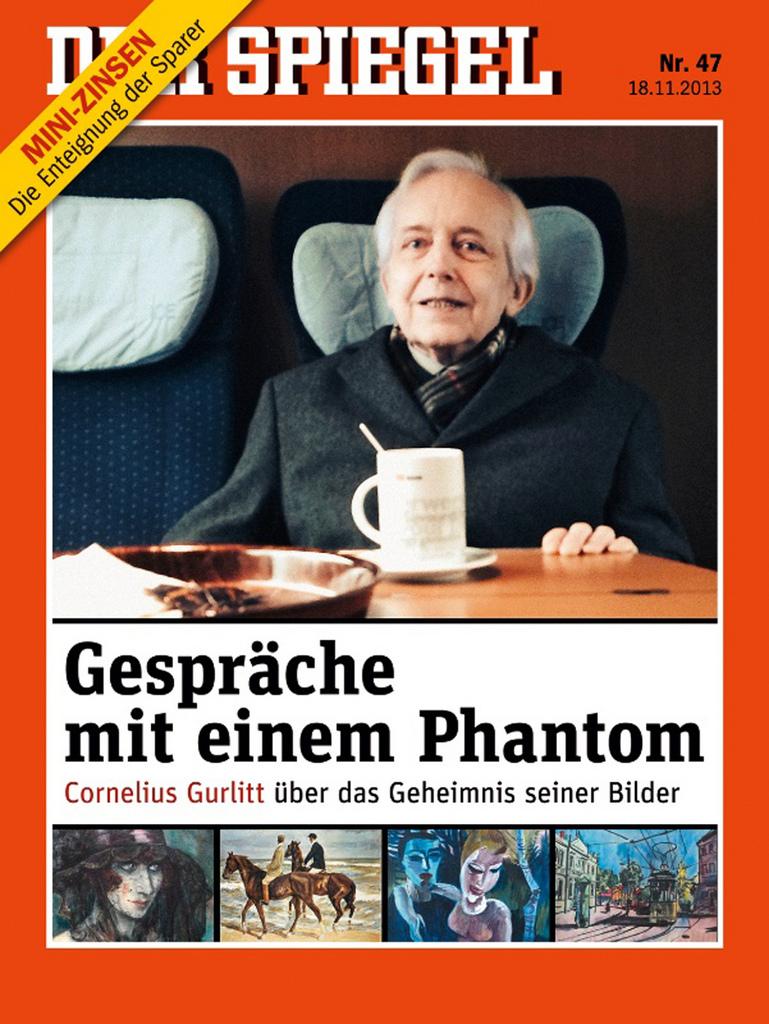
‘There’s a lot of Nazi-looted art in Switzerland’

The author of a book about the more than 1,200 works of art found in a Munich flat in 2012 tells swissinfo.ch about the “web of deceit and silence” surrounding the collection, the legal and moral situation of looted art and Switzerland’s “mixed record”.
The Munich Art Hoard by Catherine Hickley, a Berlin-based arts journalist, tells the extraordinary story of the “Gurlitt collection”. This began in 2010, when German pensioner Cornelius Gurlitt, the reclusive son of one of Hitler’s official art dealers, was randomly stopped on a train from Switzerland and found to be carrying thousands of euros (see timeline below).
The German authorities, suspecting he was a tax dodger, entered his flat and were stunned to find it full of masterpieces by artists such as Picasso, Renoir and Matisse whose value has been estimated at several hundred million francs.
When the discovery was made public in 2013, it made headlines around the world – especially when it later emerged that Bern’s Museum of Fine Art stood to inherit the entire collection.
The Munich Art Hoard, the book’s working title, will be published next year.
swissinfo.ch: Cash found on trains, hidden masterpieces, Nazis – you should be writing a film script not a book!
Catherine Hickley: Lots of people have said that. George Clooney made his film about the Monuments MenExternal link [released February 2014] – if he’d waited a bit longer he might have had a better story…
Cornelius Gurlitt
Cornelius Gurlitt was born in Hamburg on December 28, 1932, to Hildebrand Gurlitt (1895-1956), one of four official art dealers for the Nazis, and Helene Gurlitt, a dancer. His grandfather, also called Cornelius (1850-1938), was an architect and art historian; his great-grandfather, Louis Gurlitt (1812-1897), was a Danish-German landscape painter whose brother, yet another Cornelius (1820-1901), was a composer.
Gurlitt studied history of art at the University of Cologne until 1960. At the same time he studied art restoration at the Museum of Fine Arts in Düsseldorf. His father died in a car crash in 1956 and his mother died in 1968, when he inherited the art collection. In the meantime, Gurlitt had moved into a house he had built in Salzburg. His sister, Benita, died in 2012.
Gurlitt died on May 6, 2014, in his Munich flat, which he shared with between 1,200 and 1,400 works of art. He had suffered from heart problems for a while. He never married and had no children.
The Gurlitt case is fascinating. There are so many disputed paintings in museums around the world, so many claims that have yet to be resolved and so many paintings that are just lost. They could be in some museum depot or, just as likely, above someone’s fireplace!
I had been wanting to write a book about restitution and already had a proposal and an agent, who liked the subject matter but wasn’t so sure about the structure. When the story broke, I called her and said ‘I think we have our story now’.
swissinfo.ch: Imagine the faces of the people who discovered the collection! It must have been like finding Tutankhamen’s tomb.
C.H.: It seems that the customs officials and investigators who were first on the scene didn’t really grasp exactly what they had. You wouldn’t necessarily expect someone working for customs or the state prosecutor to be able to tell an Otto Dix from an Emil Nolde or whatever.
swissinfo.ch: How did Gurlitt arrange his pictures? Like other people with CDs – alphabetically, chronologically, by genre?
C.H.: He had racks with the pictures on them. He had some prints and graphics in drawers, some works in the cupboard, others in a suitcase and a couple were hanging on the wall. The art historian who viewed them said they were stored correctly. Some were slightly dirty and needed cleaning, but they had been looked after.
swissinfo.ch: Cornelius Gurlitt seems to have been a recluse who occasionally visited Switzerland to sell a painting for cash to live off. Not the easiest person to write a book about…
C.H.: He’s not. And he’s not actually the focus of my book. I’ve devoted one chapter to Cornelius Gurlitt’s life, but I think his father [Hildebrand GurlittExternal link, one of four art dealers appointed by the Nazis to sell confiscated art abroad] is the more interesting character. Cornelius Gurlitt was extremely reclusive. I’ve spoken to a few people who were at school with him and who knew him when he was younger, but finding people who knew him as an adult is extremely difficult because he eschewed contact with most people.
It’s even difficult to know where he was. Some of the time he was in his house in Salzburg, some of the time in Munich, but he blinded all the windows, didn’t answer the door, didn’t reply to letters and didn’t pick up the phone. And maybe there’s not actually that much to tell: he stayed at home and looked at his pictures…
swissinfo.ch: One might think that someone who is busted with more than a hundred million francs worth of art connected to the Nazis has done something illegal. But Gurlitt hadn’t actually broken any laws. Why did the German prosecutor come down on him so heavily?
C.H.: Most people who know a lot about the case think the seizure of his art collection was legally very hard to justify and the prosecutor acted somewhat overzealously in taking the whole lot – it was disproportionate to the suspicions that they had against him.

It began as a tax inquiry. When the money was found on him on the train, the authorities assumed he had stashed away money in Switzerland to evade taxes in Germany – there have been a lot of stories about thatExternal link, with whistle-blowers and CDs of account data being sold across the border. Customs officials are particularly watchful on trains travelling from Switzerland to Germany.
So he was caught with €9,000 (CHF10,800) – which was within his legal rights [the declaring limit is €10,000] – but, as the customs authorities put it, if you are that close to the maximum, they know you are familiar with the law and wonder why you are familiar with the law. What else have you got? That triggered the inquiry, but that in itself wouldn’t have been enough to warrant the seizure of his art collection.
So it’s still a bit of a mystery what actually happened in the 18 months or so between the train ride and the entering of his apartment. I think at one point they suspected him of being part of a shady network of dealers in southern Germany and Switzerland who were selling Nazi-looted art on the black market. But of course that was wrong.
swissinfo.ch: So legally he hadn’t done anything wrong, but morally shouldn’t he have come forward and offered to co-operate earlier?
C.H.: Of course. That’s the case with all private owners with art that they think might be looted – in the long term the art is only going to regain its value if the provenance is completely clear and transparent.
In cases where it is stolen, of course there’s a moral obligation to reach a settlement with the heirs of those who were looted and plundered by the Nazis as part of their policy of racial persecution against the Jews. It’s unthinkable to us that anyone would want to have a painting hanging on their wall that they knew was stolen from a Jewish collector who had to emigrate in order to save his life. (Listen to the audio for an explanation of why looted art is a sort of Achilles heel for a Germany which, in virtually all other respects, has worked hard to make up for its dark past.)

More
‘This is not how Germans like to see themselves’
But I wouldn’t actually put the blame all too firmly on Cornelius Gurlitt – let’s not forget that he inherited the collection in 1968 from his mother. His father [who died in 1956] lied extensively to keep it – first of all to the Allies who were investigating it after the war and secondly to the heirs of the Jewish owners who came to him asking where their art had gone, especially the stuff that he’d sold.
So there was a whole web of deceit and silence surrounding this collection that really needed to be cleared up, and in the end it was Cornelius Gurlitt who said ‘yes, I want to do this – I am willing for my collection to be examined and investigated and I’m willing to hand back the art that was stolen to the heirs of the rightful owners’.
swissinfo.ch: And a month or so later he died. The following day his will named Bern’s Museum of Fine Arts as sole heir of the collection. What did you make of that?
C.H.: I was betting that he would have left it to the museum in Salzburg, because that’s where he actually had his first home, according to where he was registered as a resident.
I’m not surprised that he didn’t leave it to Germany and I’m not surprised that he was very bitter at his treatment in Germany since 2012 when they came to seize his collection. He felt he had been really mistreated by the German authorities and I think that must be what caused him to decide that he wasn’t going to leave the collection to a German institution.
swissinfo.ch: Although Bern wasn’t a completely random choice. Switzerland does have a rather unenviable reputation as a hub for dealing Nazi-looted art – during the Second World War most stolen art was sold overseas via Switzerland. How do you rate Switzerland’s performance when it comes to the restitution of looted art?
C.H.: Switzerland has a very mixed record, and I suppose like most countries there are some museums that are more willing to hand back artworks that they know are stolen than others. However, a lot of the museums in Switzerland have not conducted provenance research, they haven’t completed an investigation of their collection in order to identify which works could have been stolen by the Nazis.

There’s also a bigger issue in Switzerland of people who sold artwork under duress in order to flee Germany, ending up in Switzerland. There’s still an awful lot of work to be done in Switzerland in clearing up the provenance of some of the collections. And of course I’m not even talking about the private collections – Switzerland has a huge history of fantastic private collections about some of which we know very little. I’m sure there’s a lot of Nazi-looted art in Switzerland.
swissinfo.ch: Bern’s Museum of Fine Arts is set to give an answer on November 24, but what’s the problem? If someone offers you more than a hundred million francs worth of masterpieces you say yes on the spot, don’t you?
C.H.: I think it was very sensible of Bern not to just jump at it – obviously there’s a huge burden of responsibility that comes with a collection like this. That said, it seems to me a bit of a no-brainer that you would say yes! Because the task force in Germany is actually doing all the provenance research – that’s the expensive thing.
On the other hand, I think Switzerland is very sensitive about its role in the Third Reich as the sort of money-lender to the Nazis and the whole issues of insurance policies, bank accounts and the gold – that’s still quite recent, that’s the 1990s. And it’s true, as you say, that Switzerland was a hub for Nazi-looted art during the war and afterwards.
swissinfo.ch: But it will say yes, won’t it?
C.H.: It would amaze me enormously if it said no. I would also think it was incredibly irresponsible, because to take six months to decide and then say no is unforgivable. The heirs are waiting to get their pictures back and the whole process has been held up by this decision making.
David TorenExternal link, for example, wants the painting of the Two Riders on the Beach by Max Liebermann that conclusively belonged to his great-uncle. He’s 89 and wants his picture as soon as possible. So to keep these elderly heirs waiting and then turn round and say ‘actually, we don’t think we’ll do it’ would be completely irresponsible.
Timeline
September 22, 2010: German custom officers carry out a routine search of passengers on a train from Switzerland and find 77-year-old Cornelius Gurlitt with €9,000 (CHF10,800) in cash (below the €10,000 reporting limit). Suspicions are raised of tax evasion.
September 23, 2011: Since Gurlitt was unemployed and with no obvious means of income, the district court of Augsburg obtains an investigation and confiscation warrant for his small flat in Munich.
February 28, 2012: The authorities enter Gurlitt’s flat and discover up to 1,400 works of art, many thought to have been lost in the war. The discovery is kept secret, while an expert gets to work on the art’s provenance.
November 3, 2013: German magazine Focus reports the story, which gets headlines around the world.
November 19, 2013: The authorities announce that paintings which unequivocally belong to Gurlitt will be returned to him.
January 28, 2014: A task force reveals that following an initial examination, 458 works are suspected of being looted.
February 10, 2014: More than 60 valuable paintings, including works by Picasso, Renoir and Monet, are found in Gurlitt’s house in Salzburg. It later turns out the Austrian property contained 238 works in total.
April 7, 2014: Gurlitt’s lawyers reach an agreement with the German government, whereby Gurlitt would voluntarily return looted artwork to the heirs or previous owners.
May 6, 2014: Gurlitt dies aged 81 in his Munich flat, not having seen his paintings since they were confiscated two years previously.
May 7, 2014: Gurlitt’s will names the Bern Museum of Fine Arts sole heir of the collection. The museum says it will take a decision on accepting the collection by the end of the year.
November 24, 2014: The board of the Bern Museum of Fine Arts will announce its decision.

In compliance with the JTI standards
More: SWI swissinfo.ch certified by the Journalism Trust Initiative






























You can find an overview of ongoing debates with our journalists here . Please join us!
If you want to start a conversation about a topic raised in this article or want to report factual errors, email us at english@swissinfo.ch.